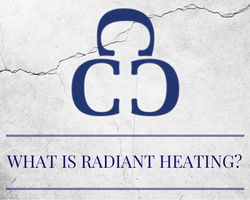
Radiant floor heating is a method used to heat home concrete floors as an alternative to a forced-air furnace. When discussing radiant floor heating, there are many things to be considered. You’ll want to make sure you fully understand what radiant floor heating is and the associated benefits, the different methods used to install, and frequently asked questions you may also hold.
What is radiant heating?
Radiant floor heating is a method used to heat your home concrete in which tubes that circulate hot water or electrical heating elements are installed in the concrete slab as it’s poured. This method allows for an even heating that permeates the concrete mass as it radiates heat throughout your home. Radiant floor heating not only allows you the comfort of a built in feet-heater, the temperature is always consistent and easy to control, you won’t feel drafts or hear the noise of blowing air, and no dust or allergens get circulated through your home through air vents. Most importantly though, radiant floor heating systems typically yield lower utility costs than a forced-air system, as home concrete radiant floor heating consumes less energy while achieving the same (if not better) level of comfort. Additionally, because concrete radiant floor heating consumes less energy, it’s good for the environment as well!
Now that you understand what exactly radiant floor heating is, let’s take a look some of the methods used to install. There are two methods used when installing radiant floor heating: water and electricity. Hydronically, water is heated by a boiler or water heater and passed through tubes that circulate the water throughout home concrete. Electrically, cables, mesh, preformed mats or elements embedded in plastic films carry heat throughout the concrete mass. With the latter option being less expensive up front because it is simpler to construct, this could prove to be a viable option for you, especially if you live in an area where electricity is more affordable than other power options. With hydronic heating of home concrete though, you have more flexibility in choosing a power source for the boiler used to heat the water. Boilers can be powered by electricity and almost any fuel (natural gas, propane, wood, and oil) as well as environmentally friendly alternatives such as a geothermal heat pumps or solar energy. There are pros and cons to both, so neither is better than the other per say; it’s just a matter of what works best for you.
After all of this, it’s likely you’ll still have some questions regarding home concrete radiant floor heating. If you find yourself one of these people, here are some FAQ you may find useful.
Find more resources on radiant heated home concrete here and here.
There are so many creative and custom options for finishing concrete, but first and foremost important is the concrete itself. At Custom Concrete Creations we have state of the art equipment and a properly trained team with years of experience. Custom Concrete Creations is a premier contractor serving the Omaha area as well at the Midwest. Give us a call or send us an email for your custom concrete finishing needs today!
